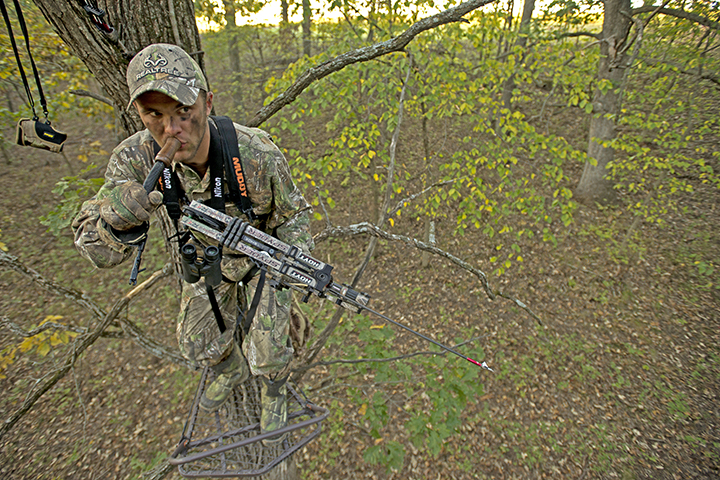By Gary Sefton
(Editor’s note: Gary Sefton is an expert caller of deer and turkeys and who has won the World Deer Calling Championship and has conducted far more than 1,000 deer calling seminars throughout the U.S. This story is excerpted from his book “CALLING WHITETAILS / Methods, Myths & Magic,” a no-nonsense, back-to-basics guide to calling deer, and other deceptions to help. Chapters include whitetail deer practical vocabulary, deer calling basics (why deer respond to calls), calling during the rut (mating anticipation), antler rattling, other deceptions (scents, blinds, decoys), tips to increase your calling success, be familiar with your calls, and have a plan. The book is available at www.targetcommbooks.com.)
 Tips to Increase Your Deer Calling Success
Tips to Increase Your Deer Calling Success
I can’t begin to tell you how many tales of woe I’ve heard from seasoned deer hunters who missed out on golden opportunities because their brains were on pause when a buck showed up.
If you believe in something like a deer call enough to buy it and haul it to the woods with you, then you should believe something is going to happen when you use it. You want the deer to come into the area to investigate the deer making the call. He may come in hard and fast or he may slip in and be gone before you know he was there.
Make the call and then wait for him! Look for him! Stay on ‘red alert’ for 15 to 20 minutes after you make the call. Expect a response and anticipate success. You will still get caught with your guard down from time to time, but you won’t feel so dumb about it.
Consistently successful callers (deer, elk, turkey, etc.) always anticipate success and prepare for a response. This anticipation is what I call the confidence factor, and it usually comes from experience and a working knowledge of the language of the game you’re hunting. You don’t have to learn the hard way. Learn the language, and when you make a deer call expect a deer to show up.
When You See a Deer
Deer have big ears. They are good at pinpointing the precise location of a sound’s origin, so my rule is: If you can see a deer coming toward you, let it come, even if it is dawdling and taking its time.
You are in good shape as long as it is headed your way. If you make a sound while it is en route, you will call its attention to your location and increase the possibility of getting picked off.
If the deer veers off in another direction, a soft doe or buck grunt could be the right invitation to bring it back on course. You don’t have anything to lose in those situations.
When I’m in this situation (the deer is not heading my way) I’ll call to any deer I see wandering around, but I keep it soft and passive unless I see or hear a buck trailing a doe. When that happens, I’m going to get more aggressive, with some heavy breathing doe bleats to try to turn his head. I have called several bucks to me that were trailing does. They thought the bleating doe was the same one they were trailing.
When you are doing blind calling, always take a hard look around before you make a call, to be sure the immediate area is clear of deer that could bust you. If you get busted, let him go. There’s no reason to call to a deer that you know you have spooked. He won’t come back once he has you pegged, and he might very well associate the call to human presence. What do you think he will do the next time he hears a call?
Learn the Language
Before your start blowing on your deer call, be make sure you know what you are saying so you don’t say the wrong thing at the wrong time. Deer can’t change their language, so just be sure you are familiar with the basics. Beyond that, you have to be the judge of what is right for you. Knowing the right sound to make to trigger a specific response gets you in the game. Making the proper sound in the correct sequence gives you a chance to score.
Set Up to Call
An important but often overlooked aspect of calling success is in the caller’s location and set-up. Do your calling in a high-deer-use area where deer are comfortable making and responding to calls. You are not going to call many deer when they are alarmed or distressed.
“What do you do when a buck comes almost close enough to shoot and won’t come any closer?” I wish I had a quarter for every time I’ve been asked that question.
The reason he won’t come any closer is because he can’t see the deer he’s been hearing. He wants visual reinforcement to the audio signals he’s been getting. A warning – if you call to him while he’s looking in your direction (he usually will be if he’s responding to a call), he’ll most likely look you right in the eye and the hunt will be over. Your best bet is to let him walk, then try to call him back when he gets out of sight.
If you plan to call, try to position your stand on a rise or in thick cover so the deer will be in range when he comes into view. Don’t forget: if you’re going to do aggressive calling or horn rattling, always try to set up with a natural barrier downwind of your stand. If you can keep a buck from scent checking your position when responding to your calling, your chances for success are much better, especially with older, smarter deer.




